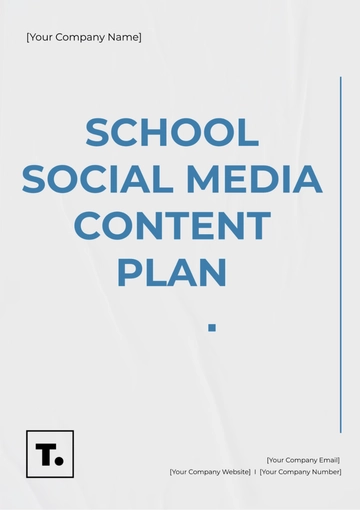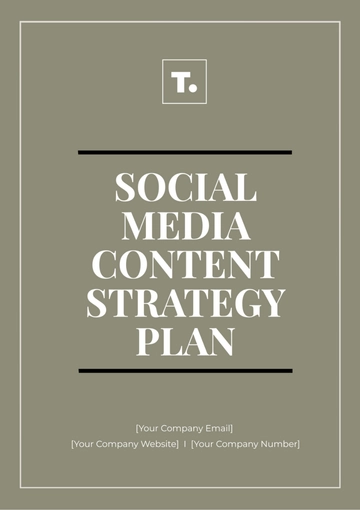Free Social Media Content Strategy Plan

Prepared by: [YOUR NAME]
Contact Email: [YOUR EMAIL]
I. Executive Summary
The Social Media Content Strategy Plan provides a comprehensive roadmap for developing and executing an effective content strategy across various social media platforms. This plan aims to achieve [OBJECTIVES] by leveraging [KEY HIGHLIGHTS]. It outlines the strategic approach for content creation, distribution, engagement, and measurement to enhance [TARGET AUDIENCE] engagement and drive [BUSINESS GOALS].
Contact Information
Company Name | [YOUR COMPANY NAME] |
Contact Person | [YOUR NAME] |
[YOUR EMAIL] | |
Phone Number | [YOUR COMPANY NUMBER] |
Address | [YOUR COMPANY ADDRESS] |
Website | [YOUR COMPANY WEBSITE] |
Social Media Profiles | [YOUR COMPANY SOCIAL MEDIA] |
II. Audience Analysis
Demographics: Understanding the demographics of the target audience including age, gender, location, income level, and education background.
Interests and Behaviors: Analyzing the interests, hobbies, online behaviors, and social media preferences of the target audience.
Challenges and Pain Points: Identifying the challenges, pain points, and needs of the target audience that the content strategy aims to address.
III. Content Goals and Objectives
Brand Awareness: Increase brand visibility and recognition among the target audience.
Audience Engagement: Foster meaningful interactions and engagement with the target audience.
Lead Generation: Generate leads and inquiries for products or services offered by [YOUR COMPANY NAME].
Traffic Generation: Drive traffic to [YOUR COMPANY WEBSITE] and increase website visits.
Conversion Optimization: Optimize content to encourage conversions and achieve business objectives.
IV. Content Calendar
Monthly Themes: Plan content around monthly themes, events, holidays, or industry trends.
Posting Schedule: Determine the frequency and timing of content posts on each social media platform.
Content Formats: Specify the types of content to be created, such as videos, images, blog posts, infographics, or user-generated content.
Content Distribution: Outline how content will be distributed across social media platforms to maximize reach and engagement.
V. Content Creation Guidelines
Brand Voice and Tone: Define the brand voice and tone to maintain consistency across all content.
Visual Branding: Establish visual branding guidelines including color schemes, fonts, and imagery.
Content Quality Standards: Set standards for content quality, relevance, accuracy, and authenticity.
SEO Optimization: Incorporate SEO best practices to improve content visibility and discoverability on social media platforms.
VI. Engagement and Interaction Plan
Community Management: Monitor comments, messages, and mentions to engage with the audience and foster community interaction.
Responding Guidelines: Establish guidelines for responding to comments, messages, and inquiries from the audience.
User-generated Content: Encourage and leverage user-generated content to increase engagement and authenticity.
Social Listening: Monitor social media conversations and sentiment to identify opportunities for engagement and content creation.
VII. Content Performance Measurement
Key Performance Indicators (KPIs): Define KPIs such as reach, engagement, click-through rates, conversions, and return on investment (ROI).
Analytics Tools: Utilize social media analytics tools to track and measure the performance of content.
Reporting: Generate regular reports to analyze content performance, identify trends, and make data-driven decisions for optimization.
Continuous Improvement: Implement strategies for continuous improvement based on insights from content performance metrics.
VIII. Conclusion
The Social Media Content Strategy Plan provides a structured framework for creating and executing an effective content strategy to achieve [OBJECTIVES]. By understanding the needs and preferences of the target audience, creating high-quality content, and fostering engagement and interaction, [YOUR COMPANY NAME] aims to enhance brand visibility, drive audience engagement, and achieve business success in the dynamic landscape of social media.
- 100% Customizable, free editor
- Access 1 Million+ Templates, photo’s & graphics
- Download or share as a template
- Click and replace photos, graphics, text, backgrounds
- Resize, crop, AI write & more
- Access advanced editor
Craft compelling social media strategies effortlessly with Template.net's Social Media Content Strategy Plan Template. This editable and customizable template, accessible via our Ai Editor Tool, streamlines your planning process. Tailor your content strategy with ease, optimizing engagement and driving results. Elevate your social media presence with precision and finesse.
You may also like
- Finance Plan
- Construction Plan
- Sales Plan
- Development Plan
- Career Plan
- Budget Plan
- HR Plan
- Education Plan
- Transition Plan
- Work Plan
- Training Plan
- Communication Plan
- Operation Plan
- Health And Safety Plan
- Strategy Plan
- Professional Development Plan
- Advertising Plan
- Risk Management Plan
- Restaurant Plan
- School Plan
- Nursing Home Patient Care Plan
- Nursing Care Plan
- Plan Event
- Startup Plan
- Social Media Plan
- Staffing Plan
- Annual Plan
- Content Plan
- Payment Plan
- Implementation Plan
- Hotel Plan
- Workout Plan
- Accounting Plan
- Campaign Plan
- Essay Plan
- 30 60 90 Day Plan
- Research Plan
- Recruitment Plan
- 90 Day Plan
- Quarterly Plan
- Emergency Plan
- 5 Year Plan
- Gym Plan
- Personal Plan
- IT and Software Plan
- Treatment Plan
- Real Estate Plan
- Law Firm Plan
- Healthcare Plan
- Improvement Plan
- Media Plan
- 5 Year Business Plan
- Learning Plan
- Marketing Campaign Plan
- Travel Agency Plan
- Cleaning Services Plan
- Interior Design Plan
- Performance Plan
- PR Plan
- Birth Plan
- Life Plan
- SEO Plan
- Disaster Recovery Plan
- Continuity Plan
- Launch Plan
- Legal Plan
- Behavior Plan
- Performance Improvement Plan
- Salon Plan
- Security Plan
- Security Management Plan
- Employee Development Plan
- Quality Plan
- Service Improvement Plan
- Growth Plan
- Incident Response Plan
- Basketball Plan
- Emergency Action Plan
- Product Launch Plan
- Spa Plan
- Employee Training Plan
- Data Analysis Plan
- Employee Action Plan
- Territory Plan
- Audit Plan
- Classroom Plan
- Activity Plan
- Parenting Plan
- Care Plan
- Project Execution Plan
- Exercise Plan
- Internship Plan
- Software Development Plan
- Continuous Improvement Plan
- Leave Plan
- 90 Day Sales Plan
- Advertising Agency Plan
- Employee Transition Plan
- Smart Action Plan
- Workplace Safety Plan
- Behavior Change Plan
- Contingency Plan
- Continuity of Operations Plan
- Health Plan
- Quality Control Plan
- Self Plan
- Sports Development Plan
- Change Management Plan
- Ecommerce Plan
- Personal Financial Plan
- Process Improvement Plan
- 30-60-90 Day Sales Plan
- Crisis Management Plan
- Engagement Plan
- Execution Plan
- Pandemic Plan
- Quality Assurance Plan
- Service Continuity Plan
- Agile Project Plan
- Fundraising Plan
- Job Transition Plan
- Asset Maintenance Plan
- Maintenance Plan
- Software Test Plan
- Staff Training and Development Plan
- 3 Year Plan
- Brand Activation Plan
- Release Plan
- Resource Plan
- Risk Mitigation Plan
- Teacher Plan
- 30 60 90 Day Plan for New Manager
- Food Safety Plan
- Food Truck Plan
- Hiring Plan
- Quality Management Plan
- Wellness Plan
- Behavior Intervention Plan
- Bonus Plan
- Investment Plan
- Maternity Leave Plan
- Pandemic Response Plan
- Succession Planning
- Coaching Plan
- Configuration Management Plan
- Remote Work Plan
- Self Care Plan
- Teaching Plan
- 100-Day Plan
- HACCP Plan
- Student Plan
- Sustainability Plan
- 30 60 90 Day Plan for Interview
- Access Plan
- Site Specific Safety Plan





























